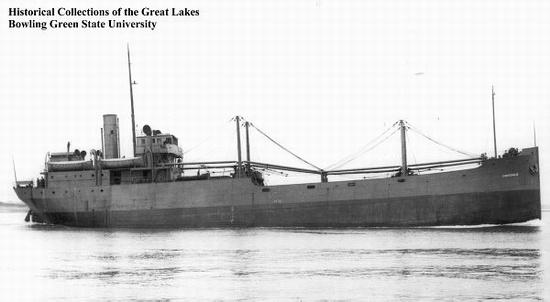Cathrine
British Motor merchant

Cathrine under her former name Covedale
| Name | Cathrine | ||
| Type: | Motor merchant | ||
| Tonnage | 2,727 tons | ||
| Completed | 1919 - Great Lakes Engineering Works, Ecorse MI | ||
| Owner | George Gibson & Co Ltd, Leith | ||
| Homeport | Grangemouth | ||
| Date of attack | 17 Jun 1941 | Nationality: | |
| Fate | Sunk by U-43 (Wolfgang Lüth) | ||
| Position | 49° 09'N, 25° 05'W - Grid BD 3933 | ||
| Complement | 27 (24 dead and 3 survivors). | ||
| Convoy | SL-76 (straggler) | ||
| Route | Pepel - Freetown (30 May) - Barrow | ||
| Cargo | 3920 tons of iron ore concentrates | ||
| History | Completed in May 1919 as steam merchant Covedale for the US Shipping Board (USSB). 1922 converted to motor merchant Muncove for Munson SS Lines Inc, New York. 1939 sold to Estonia and reamed Peeter for J. Inkapool & Co, Tallinn. 1940 renamed Cathrine and registered in Panama for John Carlbom & Co, Hull. 1941 taken over by the Ministry of War Transport (MoWT). | ||
| Notes on event | At 03.15 hours on 17 June 1941 the unescorted Cathrine (Master Johannes Teng), a straggler from station #123 in convoy SL-76, was hit by two torpedoes from U-43 about 600 miles west of Cape Clear. The ship immediately broke in two and disappeared within two minutes. The survivors had no time to launch the lifeboats and clung to wreckage, rafts and an upturned boat after jumping overboard. The U-boat approached to hailing distance some 15 minutes after the ship sank and the Germans reportedly asked the survivors whether they were all right but none of the men replied because they found the question quite absurd, so the U-boat left without questioning them further. Four of the fourteen men clinging to the upturned lifeboat lost their grip and drowned during the day, before the remaining survivors managed to right the boat with the help of a sea anchor and baled it out. At about sunrise on 20 June, U-204 (Kell) spotted this lifeboat and shortly thereafter a raft from the same vessel in approx. 48°45N/23°15W. The survivors later stated that they asked the Germans for water but were told: We have no water for Britishers. The U-boat then left without having asked the usual questions about the name of the vessel, its port of departure or cargo. Subsequently seven of the ten occupants of the lifeboat died from starvation and exposure. During the last eight days there was no food on board and only a small quantity or rain water to sustain them. One day, a convoy passed about half a mile away, but they were much too weak to attract attention of the ships or the aircraft overhead. On 19 July, only three men were still alive when the boat was found by the British steam trawler Boreas 35 miles west of Valentia Bay, Co. Kerry. They were landed at Valentia and admitted to a hospital to recover from their ordeal. The master, 21 crew members and two gunners were lost. | ||
| On board | We have details of 27 people who were on board. | ||
If you can help us with any additional information on this vessel then please contact us.
